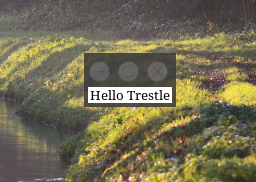Modula3 - installation and getting started
Introduction
Modula3 is a programming language based on Pascal and Modula 2 from Niklaus Wirth. Modula 3 has been developed around ~1992 by DEC with the blessing of Mr. Wirth.
Modula3 is strongly typed, has a powerfull module system and has generics, Object oriented additions as well as build in support for concurrent programming. The additons to the language add some compfort to programming.
It also seems to be an historic oversight that the multi platform GUI library Trestle has not become more well known and popular.
The Trestle multi-platform GUI library from beginning of the 90th allows you to write Modula3 programms for X11 and Windows (Win32) with the same code and it all still works. In 1994 that was almost unique. Well worth to explore a bit.
Installation
There is an up-to-date Modula3 compiler that installs and runs well on the Pinebook with Manjaro: CM3
A good install guide is in the Wiki
For the Pinebook Pro (aarch64) I have successfully used the tar-file for AMD64.
Also note the --target ARM64_LINUX parameter when the build script is called. This is needed for Aarch64 systems as decumented here
The steps to initial install on Manjaro are:
curl -LO https://github.com/modula3/cm3/releases/download/d5.11.4/cm3-dist-AMD64_LINUX-d5.11.4.tar.xz
tar xf cm3-dist-AMD64_LINUX-d5.11.4.tar.xz
mkdir build
cd build
../cm3-dist-AMD64_LINUX-d5.11.4/scripts/concierge.py install --prefix $HOME/cm3 --target ARM64_LINUX all
PATH=$HOME/cm3/bin:$PATH
Optional, after the build of the release the latest version from Github can be installed:
git clone https://github.com/modula3/cm3 cm3-git
mkdir build
cd build
../cm3-git/scripts/concierge.py install --prefix $HOME/cm3 all --target ARM64_LINUX
Notes for the install process:
- The final install folder is called
cm3, that's why the git folder is calledcm3-gitto keep things seperate - You probaly don't have to install all prerequisites. Some are installed already
- the
buildfolder is created on the same level as thecm3-gitfolder
Some reading
The compile process takes some time on the Pinebook Pro. This is probably a good opportunity to have a look at some of the highlights of the documentation:
- Modula3 web site
- A good overview of the language can be found here. More a reference with examples than a tutorial.
- Overview of the Standard Library. Modula3 is very module oriented, so this is a good start.
- The highlight for me is the GUI library Trestle. (Some makefiles in this document are in an older version and need small updates like "" added for names.)
The highlight for me is definately the GUI library Trestle. Works perfect on Manjaro with X11. I have not tested it on Windows, but apparently that works as well. For an 30 years old library that is truely remarkable.
Have I mentiond the WYSIWYG GUI design app FormsVBT already ?

So, now the install should be completed. The compiler has been installed in ~/cm3
Add this bin folder to the PATH export PATH="$HOME/cm3/bin:$PATH"
Getting started with Modula3
Example 1: Hello World
Before the eample here is the first m3makefile. Some help for the m3mankefile is here. For a small emaple it is not strictly neccessary but this is how Modula3 ticks so let's just use it:
Create a folder
exampleCreate a subfolderexample/srcCreate the makefileexample/src/m3makefileCreate the Modula3 exampleexample/src/Hello.m3
m3makefile
% HelloTrestle
import ( "ui")
implementation ("Hello")
program ("Hello")
Hello.m3
MODULE Hello EXPORTS Main;
IMPORT TextVBT, Trestle;
VAR v := TextVBT.New("Hello Trestle on Pinebook");
BEGIN
Trestle.Install(v);
Trestle.AwaitDelete(v)
END Hello.
In folder example use the command cm3 and the programme will be compiled.
The result is in ARM64_LINUX/. Start the example with ./ARM64_LINUX/Hello.
You get a nice little Window with a Hello message.

If you compare the m3makefile to some documentation you will also notice how to update some of the older m3makefiles mentioned there. Often additional "" are needed.
Example 2: Module concept
Modula3 has it's name from the module concept. Her eis how it works:
Every module has an interface definition in a file with .i3 ending. The implementation is in a file with .m3 ending.
Create another folder
example2Createexample2/src
Place all files into the src/ folder:
The Interface description looks like this: A.i3
INTERFACE A;
PROCEDURE DoIt();
END A.
Here is the implementation of the interface: A.m3:
MODULE A;
IMPORT IO;
PROCEDURE DoIt() =
BEGIN
IO.Put("Hello World\n");
END DoIt;
BEGIN
END A.
And the main programe: Example2.m3:
MODULE Example2 EXPORTS Main;
IMPORT A;
BEGIN
A.DoIt();
END Example2.
All brought together with the m3makefile
import ("libm3")
implementation ("Example2")
module ("A")
program ("test2")
Although some of the source material and documentation is old it still works nicely and Modula3 is even by todays standards a very useful, flexible and pleasant language. The kink with the capitalised KEYWORDS is sorted in the editor, e.g. Emacs or VSCode. You don't need to actually types like that but it makes the structure of the source code very clear and readable.
Appendix
Emacs support
The file to support Emacs can be found here in folder []https://github.com/modula3/cm3/tree/master/m3-tools/gnuemacs/src)
Add this to your init.el:
;; Path to cm3 modula3 mode
(add-to-list 'load-path "/home/mmw/.local/cm3-git/m3-tools/gnuemacs/src") ;; update to your path
(autoload 'modula-3-mode "modula3")
(setq auto-mode-alist
(append '(("\\.ig$" . modula-3-mode)
("\\.mg$" . modula-3-mode)
("\\.i3$" . modula-3-mode)
("\\.m3$" . modula-3-mode))
auto-mode-alist))
(setq completion-ignored-extensions
(append '(".mo" ".mx" ".mc" ".io" ".ix") completion-ignored-extensions))
Language server
https://github.com/modula3/cm3/tree/master/m3-tools/langserver
Kate editor support
https://github.com/modula3/cm3/tree/master/m3-tools/kate
VSCode
Next to the language server, there is a package for syntax highlighting: https://github.com/newgrammars/vsce-cm3vsc